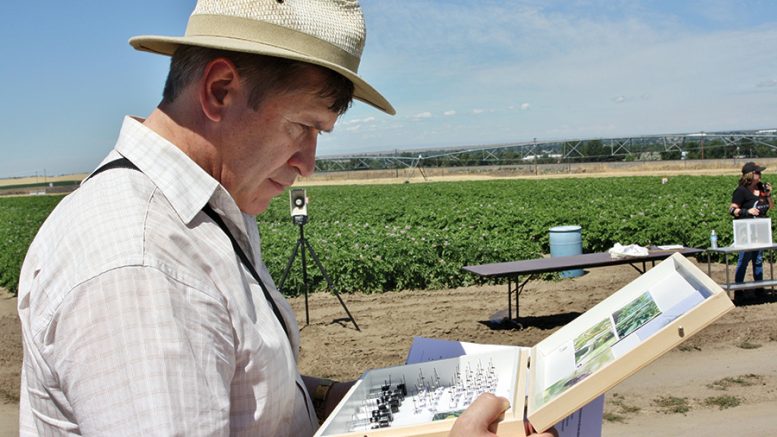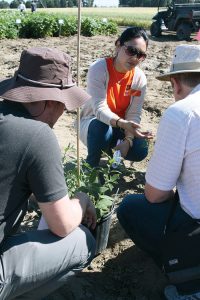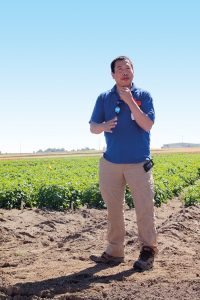
Ray Qin, an OSU agronomist, talks about his research to develop nutrient management guidelines for new varieties Echo Russet and Castle Russet.
New potato varieties and new potato pathogens are at the center of two research projects at Oregon State University (OSU). One study looks at nutrient management of new varieties Echo Russet and Castle Russet. Early results suggest Echo Russet might save growers money in fertilizer costs. Meanwhile, another trial will put a price tag on the impact of potato soft rot pathogens.
Management recommendations for the new varieties and soft rot pathogens are in the works and were among the topics covered at the OSU Potato Field Day, held June 20 at OSU’s Hermiston Agricultural Research and Extension Center.
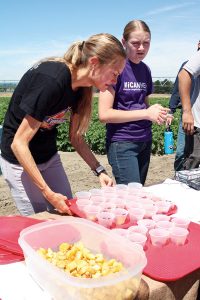
OSU’s Angie Treadwell passes out samples of roasted potatoes that she promotes at school lunch programs in the Hermiston area.
Nutrient Management
The Northwest Potato Variety Development Program, or Tri-State Program, released two new varieties, Echo Russet and Castle Russet, earlier this year. Echo Russet is a high-yielding, long, medium- to late-season russet with cold sweetening resistance and excellent processing qualities. Castle Russet is described as a long, medium- to late-season russet suitable for the fresh and processing markets with an exceptional disease resistance package.
Currently, nutrient management plans for the new cultivars are based on older varieties such as Ranger Russet and Russet Burbank. Seeing a need to determine the nutrient requirements of the new varieties, Ruijun “Ray” Qin, an OSU agronomist, set up a study to develop nutrient management guidelines specific to Echo Russet and Castle Russet.
In a field trial, Qin is evaluating various nitrogen application rates for Echo Russet, Castle Russet, Ranger Russet and Russet Burbank. Throughout the growing season, he is monitoring potato petiole nitrate levels. And at harvest, he will collect quality and yield data to identify the ideal nitrogen application rate that will produce the highest yield and best quality.
This is the second year of the trial. Qin stressed that with only one year of data in the books, his results are not yet conclusive. With that in mind, he reported that last year’s trial showed that Echo Russet may have the lowest nitrogen requirement, or the highest nitrogen use efficiency, when comparing all the varieties under the same nitrogen application level, especially when the nitrogen rate is limited. Castle Russet’s nitrogen use efficiency tended to be similar to Ranger Russet. Russet Burbank had the lowest nitrogen use efficiency, as well as the lowest yield and quality under any nitrogen application rate.
“Through this research, I really hope to help growers improve nitrogen use efficiency, find the ideal application rate to achieve ideal yield and, at the same time, reduce the nitrogen leaching problem,” Qin said.
“This is new research for the region. Whenever you do something new, it’s always exciting,” he continued. “I will be very happy if my work could help my clientele achieve sustaining crop productivities and improve their profits in the region.”
In addition to the nitrogen management trial, Qin is also working on a potassium fertilization study and is interested in conducting research on soil health and soil fumigation strategies for potatoes.
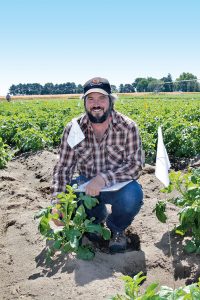
Ken Frost, an OSU plant pathologist, is conducting a trial to evaluate the economic impact of soft rot caused by species of Pectobacterium and Dickeya.
Soft Rot Trial
Ken Frost, an OSU plant pathologist, is looking at the economic impact of soft rot caused by species of Pectobacterium and Dickeya. The organisms can cause blackleg on potato plants and soft rot in tubers and can reduce emergence and yield in susceptible varieties.
His trial includes Lamoka, a variety known to be susceptible to soft rot pathogens, and the more resistant Russet Burbank. Frost is attempting to establish disease thresholds by inoculating seed with Pectobacterium carotovorum and Dickeya chrysanthemi. Treatments vary by the amount of infected seed, ranging from 0 to 30 percent infected seed. Throughout the trial, he is evaluating plant emergence and growth, disease and yield and will determine the relationship between the amount of initial inoculum in the seed and the resulting yield.
So far, Lamoka has had very poor emergence, with emergence tending to correlate with the percentage of initial seed infection; the higher the initial infection, the worse the emergence. Russet Burbank did not show significant differences in emergence. After harvesting the trial, Frost plans to store the tubers in order to assess the extent to which soft rot develops in storage.
Data from the trial will be provided to economists to assess the cost of soft rot and blackleg to U.S. potato production both regionally and nationally.
“That information is important to have because the organisms in the Dickeya genus were detected in the potato production system in the eastern U.S. in 2015. Folks were really scared about what impacts this new pathogen might have for the industry,” Frost explained. “Now we’re three years after that initial detection, and we know that the Dickeya pathogens have been detected in nearly every state where potatoes are grown. There’s still concern about it and about economic losses associated with it.”
As with the introduction of any new pathogen, Frost says it’s important to understand the organism and to quantify its potential impact on the industry.
“If we know how much it’s going to cost, we might know how much we could spend to prevent it or reduce its incidence in seed that gets planted,” he added.
Frost reminded growers to be aware that cultivars vary in resistance to soft rot pathogens, so it’s important to select varieties carefully. Also purchase the cleanest seed possible, and be vigilant in management and handling of seed to prevent soft rot diseases.

